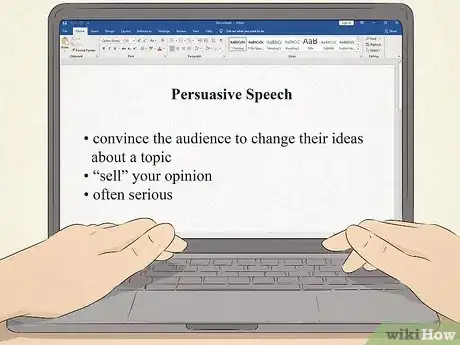This article was co-authored by Lynn Kirkham. Lynn Kirkham is a Professional Public Speaker and Founder of Yes You Can Speak, a San Francisco Bay Area-based public speaking educational business empowering thousands of professionals to take command of whatever stage they've been given - from job interviews, boardroom talks to TEDx and large conference platforms. Lynn was chosen as the official TEDx Berkeley speaker coach for the last four years and has worked with executives at Google, Facebook, Intuit, Genentech, Intel, VMware, and others.
There are 16 references cited in this article, which can be found at the bottom of the page.
This article has been viewed 388,096 times.
The best way to start a speech depends on the type and topic of the speech, your audience, and the overall tone of the event. The best way to ensure a successful speech is to grab your audience’s attention in the beginning of the speech; if you do so, they will likely stick with you to the very end. While there is no one way to capture an audience’s attention, there are several methods that may work. Choose the one that is the best fit for the event and your own personality.
Steps
Winning Your Audience’s Attention
-
1Begin with a joke. As long as the occasion is a fairly lighthearted one, a joke or a bit of humor can be a great way to start an entertainment or occasion speech. Just make sure that your use of humor does not offend anyone in the audience.[1]
- At an event held in honor of a particular person, you might tell a humorous story involving you and the person being honored. Just make sure that the story or joke is not embarrassing or potentially offensive.
- Try out your joke on a few different people before delivering it in your speech. If the joke falls flat or is offensive, cut it from your speech.[2]
-
2Make a startling statement. A startling statement shocks or startles an audience into paying attention. Since these statements often evoke a strong emotional reaction, making one at the start of your speech can engage the audience quickly.
- Try something simple that cuts to the chase, like “Seat belts save lives.”
Advertisement -
3Make a bold declarative statement. A daring declarative statement can shock or stun the audience into paying attention to a seemingly important topic. You might also say, in no uncertain terms, that the audience needs to learn the information you intend to deliver to them.
- If your speech is about mood disorders, you might make a statement along the lines of, “Depression, manic depression, and mood disorders of a similar strain can have deadly side effects.”
- If you are giving a speech on self-defense, you could say something like, “If you're out alone and suddenly assaulted, your reaction in the first few seconds can be the difference between survival and death.”
-
4Evoke a sense of suspense or curiosity. Describe something before revealing what that something is. By describing the characteristics of something, you invite the audience to try to unravel the mystery before you reveal the answer, forcing them to become active listeners.
- For a speech about dogs, you could describe the standard characteristics or daily life of a dog using a first person point of view, and end with the statement, “I am a dog.”
-
5Introduce a startling fact or statistic. A startling statistic can alert your audience to the importance of your chosen topic. As a result, the audience is more likely to pay attention to what you have to say about the topic.[3]
- A statistic about declining or increasing birthrates in a specific region or country could alert people to population issues.
-
6Offer surprising statistics and other evidence. Evidence should be an essential element throughout your entire persuasive speech, but if you want to make a strong case for yourself at the very beginning of your speech, a good way to do so is to provide the audience with a statistic or other similar evidence that demonstrates the importance of your claim. The statistic will be more effective if it will likely surprise your audience.[4]
- For a speech in which you are trying to persuade the audience to take protective measures against the sun, you can bring up a statistic relating to the number of people who die from skin cancer on an annual year.
-
7Tell a story or an anecdote. Stories connect to an audience by combining information with entertainment. The story you choose for the start of your speech can be real or fictional, but either way, it should have a clear connection to the topic of your speech.[5]
- For a speech about maternity care in the United States, you could tell a story about an experience related to maternity care that you or someone you know went through.
- If you were delivering a speech about how to bake a cake to kids or teens, you might describe a situation in which a child made a cake for a parent or loved one for a special occasion. Include details about how the recipient appreciated the gesture.
-
8Offer an appropriate quotation. A pithy or witty quotation that relates to the topic of your speech can present a strong statement for you to build the rest of your speech's content. For an inspirational or entertaining speech about a particular occasion, use a quotation that applies to the occasion or appeals to the audience's interests.[6]
- Try to choose a quote from a well-known source, since more people will likely respond to it if they recognize who spoke it.
- Inspirational quotes are a popular way to open a graduation speech. Usually, the speaker would choose a quote that talks about dreams, education, looking toward the future, or building character.
- Quotations are not often used to start demonstrative speeches.
-
9State an expert's opinion. If you can find an expert on the topic who agrees with your stance, quote or paraphrase that expert's opinion to provide your speech and position with a strong foundation from the start.
- If you are trying to persuade an audience about the importance of forming healthy eating and exercising habits, you might start with a statement made by a well-known expert on the matter to engage the audience.
-
10Use a striking visual aid. When your intention is to deliver a speech that instructs audiences about how to produce some sort of tangible product or result, showing off a “finished work” at the start of your speech can intrigue the audience and make them want to learn how to accomplish the same results.
- For a speech about how to lose weight, you could begin by showing before and after pictures of people who used the method you are about to describe.
-
11Give a testimonial. If you are trying to sell a product or idea, or if you are trying to explain why a certain course of action is beneficial, a testimonial can engage the audience by introducing a story to them while simultaneously convincing them of the beneficial element of whatever you are trying to pitch.[7]
- If you are trying to persuade an audience to buy a specific language learning program, you could give an example of someone who used that program and who now lives in a country that speaks the language learned.
Engaging Audience Participation
-
1Ask a survey question. Ask the audience’s position on a particular topic to get a sense of where your audience is coming from. This helps the audience get invested in the information you’re sharing and makes it relevant for them.[8]
- For a speech about how to winterize your car, you could ask the audience something like, “How many of you have ever felt your car slipping on an icy street? Or who here has had their car stall on the side of the road during freezing temperatures?”
-
2Pose a rhetorical question. By asking the audience a question about your topic, you engage them almost instantly. The audience members will hear the question and begin to ponder their own answers, thereby becoming involved in the topic of your speech.[9]
- If you are giving a speech about holiday traditions, you could ask, “What was your favorite holiday tradition growing up?”
-
3Ask the audience to visualize something. Lead your audience through a very brief visualization exercise to inspire their imagination as it pertains to your topic. They may not remember your words as much as the images that were evoked in their minds during this part of the speech.
- For example, if you’re giving a speech about booking a dream vacation, you might start with: “Imagine you are on a tropical beach. Feel the sand under your feet and the sun beating down on your shoulders. You can hear the ocean waves and wind swishing through the palm trees.”
-
4Get suggestions from the audience. When people listen to a speech, they often are looking for answers to questions that they have. Giving your audience the opportunity to ask questions up front can help shape your speech and make sure you’re addressing their specific concerns.
- If you’re giving a speech about teaching online classes versus in-person classes, you might ask, “What’s your biggest concern about teaching an online class?” Call on a few people to hear their concerns. Chances are, you’ll be addressing their concerns in your speech already.
-
5Ask the audience to talk to each other. Start off your speech by asking your audience to share something with their neighbor. This breaks the ice, making a more friendly and communal learning environment.[10]
- You might say to the audience, “Turn to your neighbor and tell them your favorite kind of exercise.”
-
6Describe a relatable scenario. If you need to persuade an audience to buy into an idea or to purchase a product, explaining to that audience why that idea or product relates to their own lives can be an effective way of getting them interested in what you have to say.[11]
- If you are trying to explain why the audience should buy a certain kitchen utensil, open by describing a common scenario that might happen in the kitchen for which that utensil could be used.
Improving Your Ethos
-
1Extend a personal greeting. In most entertaining speeches, you can take a fairly lighthearted and personal tone. Speakers often introduce themselves to the audience. Within the introduction, the speaker should explain the connection he or she has to the matter at hand and use that explanation to bridge into the speech.
- This is most often seen at eulogies and weddings. The speaker introduces himself or herself and begins to explain who they are in connection to the subject being addressed. If you are delivering a wedding toast, you might begin by talking about your connection to the bride, groom, or couple getting married.
- It can also be used at an event being held by an organization. In that case, the speaker might explain her position within the organization.
-
2Recount your connection to the subject. Speakers often begin a speech by referring directly to the topic at hand. This makes an immediate connection to the audience, whose members are all there for the sake of the same subject.
-
3Tell a personal story. When you have a personal connection to the subject of your speech, a common way to start your speech would be to share a personal story that demonstrates that connection.
-
4Refer to a current event. Incorporating current news stories is a good strategy because it confirms to the audience that your speech is relevant. Make a link between your speech topic and a current event by referring to something that has happened recently in the news.[12]
- For example, if your speech is about the lack of women working in technology, you might find a recent story about how girls are being discouraged from pursuing science in high school.
-
5Refer to a historical event or person. Start your speech by mentioning a relevant historical event in order to give your audience a common reference point.[13] For example, if your speech is about overcoming challenges, you could talk about a historical figure who did just that, such as Helen Keller.
-
6Connect to the conference theme. Many speeches are given at professional or academic conferences. These events often have a theme that provides a sense of coherence to the overall purpose of the conference. Connect the beginning of your speech to this theme.[14]
-
7Refer to the occasion. For a speech delivered at a particular occasion or event, speakers often begin their presentation by talking directly about that occasion or event. Since everyone in the audience is presumably there to acknowledge the same occasion, immediately talking about that occasion is a good way to make an instant connection to the audience.
- If you were giving a speech at a Christmas party or fundraiser, you could talk about your Christmas memories or something you love about the season.
Understanding Types of Speeches
-
1Give an informative speech to deliver information. Informative speeches are very basic and only provide factual, useful information to an audience without making judgments on that information.[15]
- The tone of an informative speech is usually fairly flexible and often dependent on the topic of the speech. For instance, a speech about cancer would demand a serious start and serious tone, while one about the history of the yo-yo would be very lighthearted.
-
2Use a demonstrative speech to explain a process. Demonstrative speeches are generally designed to teach an audience how to do something instead of teaching them about something.[16]
- Demonstrative speeches are often on the lighthearted and non-academic side, so the openings of such speeches tend to be more relaxed. That said, if you do end up dealing with a serious topic, such as how to stay safe in a hurricane or tornado, make your introduction and overall speech fairly serious.
-
3Give a persuasive speech to convince your audience of something. Persuasive speeches strive to convince the audience to change their ideas or behaviors about a topic and should use an appropriate tone to communicate that persuasion.[17]
- These types of speeches can be the most difficult to deliver because, as the speaker, you have to be engaging enough to "sell" your opinion to those listening in.
- Persuasive speeches are often serious and may use a serious opening, especially if the speaker is trying to persuade an audience to take a certain beneficial action or to adopt a new perspective about a topic. The only time that a persuasive speech might take on a more casual, lighthearted tone is when the speaker is trying to sell an actual product.
-
4Commemorate an event with a speech. This category of speeches covers a wide range of tones and purposes; these include speeches for weddings, funerals, graduations, and other events. These speeches focus on values and qualities about particular people that you highlight in the speech. Tailor-fit your introduction to match the tone of the occasion in question. [18]
- A serious or sorrowful occasion will usually call for a somber or nostalgic tone, but a celebratory occasion demands an opening and a speech that is entertaining or uplifting. For instance, a speech delivered at someone's wedding should be a lot more lighthearted than one delivered as a eulogy, and both will be very personal. A graduation speech must be general enough to relate to a wide audience.
-
5Know your audience. Getting a sense of who will be in your audience before writing your speech will help you tailor your speech in the right direction. For example, if your audience is a group of community business leaders, you will address them differently than you would address a group of teenagers.[19]
Delivering the Speech
-
1Rehearse your speech beforehand. Take some time to run through your speech a few times. Check it for timing and trim if necessary. Ask for feedback from a friend.[20]
- This will ensure that you’re comfortable with the speech and you’ll be able to relax a bit.
- Memorize the first sentence of your speech. This will help you overcome anxiety of starting out the speech strongly. Bring a hard copy of your speech with you as well.
-
2Test your technology beforehand. If you are using any visual aids such as PowerPoint, test your technology to make sure everything is hooked up correctly and is working.[21]
-
3Have a glass of water nearby. Many people get a dry mouth when they are speaking, so be sure to bring some water with you. Take a small sip just before you start speaking.
- If you are giving a brief speech, you likely won’t need to drink any water in the middle of your speech. If your speech is longer, then you might want to find a good moment to pause and take a small sip. Don’t gulp the water down; you will risk spilling it on your shirt or making yourself cough.
-
4Start with a confident voice and body language. Start your speech with a strong voice. Make sure your body language projects confidence. Stand tall with your shoulders back and your head high. Take some deep breaths before the speech starts in order to calm your body and mind.
-
5Don’t start off with apologies. Don’t start your speech with a comment such as, “I’m sorry if this speech seems disorganized,” or “I apologize for my nervousness.” The audience will only know it if you tell them. If you act prepared and organized, your audience will assume that you are.
-
6Maintain eye contact with the audience. Look out into the audience while you’re speaking. If you feel shy or embarrassed about looking at people, choose a spot just above the audience’s heads or a point on the back wall.[22]
-
7Don’t just read from your paper. It is more difficult for the audience to pay attention when you are only reading directly from your paper. Instead, look up frequently to assess the audience’s engagement with your material.[23]
Expert Q&A
Did you know you can get expert answers for this article?
Unlock expert answers by supporting wikiHow
-
QuestionHow do you start a good speech?
 Lynn KirkhamLynn Kirkham is a Professional Public Speaker and Founder of Yes You Can Speak, a San Francisco Bay Area-based public speaking educational business empowering thousands of professionals to take command of whatever stage they've been given - from job interviews, boardroom talks to TEDx and large conference platforms. Lynn was chosen as the official TEDx Berkeley speaker coach for the last four years and has worked with executives at Google, Facebook, Intuit, Genentech, Intel, VMware, and others.
Lynn KirkhamLynn Kirkham is a Professional Public Speaker and Founder of Yes You Can Speak, a San Francisco Bay Area-based public speaking educational business empowering thousands of professionals to take command of whatever stage they've been given - from job interviews, boardroom talks to TEDx and large conference platforms. Lynn was chosen as the official TEDx Berkeley speaker coach for the last four years and has worked with executives at Google, Facebook, Intuit, Genentech, Intel, VMware, and others.
Public Speaking Coach One easy way to do this is to start with a question. Try to choose a question that you're sure the audience will identify with to get them invested in the speech. For example, you may ask, "How many of you are afraid of public speaking?" This will also help you connect with your audience since it will let them know you have a kind of common ground to start with.
One easy way to do this is to start with a question. Try to choose a question that you're sure the audience will identify with to get them invested in the speech. For example, you may ask, "How many of you are afraid of public speaking?" This will also help you connect with your audience since it will let them know you have a kind of common ground to start with. -
QuestionHow can I start a speech about forgiveness?
 Community AnswerYou could say, "Everyone in this room has done something wrong and has asked to be forgiven..."
Community AnswerYou could say, "Everyone in this room has done something wrong and has asked to be forgiven..." -
QuestionHow can I get the attention of the judges in an international competition?
 Community AnswerYou could start with asking them a direct question or present a shocking fact to emotionally grab them and your audience.
Community AnswerYou could start with asking them a direct question or present a shocking fact to emotionally grab them and your audience.
References
- ↑ https://www.indeed.com/career-advice/career-development/attention-getters-for-speeches
- ↑ http://www.amanet.org/training/articles/Start-Your-Speech-Out-Right.aspx
- ↑ https://open.lib.umn.edu/publicspeaking/chapter/9-2-the-attention-getter-the-first-step-of-an-introduction/
- ↑ http://libguides.lamar.edu/content.php?pid=23277&sid=2818461
- ↑ https://open.lib.umn.edu/publicspeaking/chapter/9-2-the-attention-getter-the-first-step-of-an-introduction/
- ↑ Lynn Kirkham. Public Speaking Coach. Expert Interview. 20 November 2019.
- ↑ https://courses.lumenlearning.com/suny-publicspeakingprinciples/chapter/using-testimony/
- ↑ Lynn Kirkham. Public Speaking Coach. Expert Interview. 20 November 2019.
- ↑ Lynn Kirkham. Public Speaking Coach. Expert Interview. 20 November 2019.
- ↑ http://www.amanet.org/training/articles/Start-Your-Speech-Out-Right.aspx
- ↑ https://www.hamilton.edu/academics/centers/oralcommunication/guides/how-to-engage-your-audience-and-keep-them-with-you
- ↑ http://www.amanet.org/training/articles/Start-Your-Speech-Out-Right.aspx
- ↑ http://www.amanet.org/training/articles/Start-Your-Speech-Out-Right.aspx
- ↑ https://open.lib.umn.edu/publicspeaking/chapter/18-2-special-occasion-speeches/
- ↑ https://open.lib.umn.edu/communication/chapter/11-1-informative-speeches/
- ↑ https://guides.baker.edu/c.php?g=920494&p=6633069
- ↑ http://www.comm.pitt.edu/persuasive-speaking
- ↑ http://www.comm.pitt.edu/commemorative-speaking
- ↑ https://www.asme.org/topics-resources/content/public-speaking-know-your-audience
- ↑ https://hbr.org/2019/09/how-to-rehearse-for-an-important-presentation
- ↑ <https://opentextbc.ca/studentsuccess/chapter/presentation-aids/
- ↑ https://www.canr.msu.edu/news/eye_contact_tips_to_make_your_presentations_stronger
- ↑ https://www.student.unsw.edu.au/speaking-audience
About This Article
How you start a speech will depend a lot on what it’s about, but you should always aim to grab your audience’s attention. You should start by introducing yourself and explaining your connection to the topic. For example, if you’re giving a wedding toast, talk about how you know the married couple. Speak in a clear, loud voice, which will encourage your audience to pay attention. Telling a joke can be a good way to break the ice and focus your audience on what you’re saying, but make sure humor is appropriate for the occasion first. Alternatively, make a startling statement about your topic. For instance, you could begin a speech about self-defense by saying, “If you’re out alone and get assaulted, the way you respond in the first few seconds can make the difference between life and death.” As you speak, look out at the audience and maintain eye contact, which will make your speech more engaging. For tips on how to prepare to deliver your speech, read on!



































































































